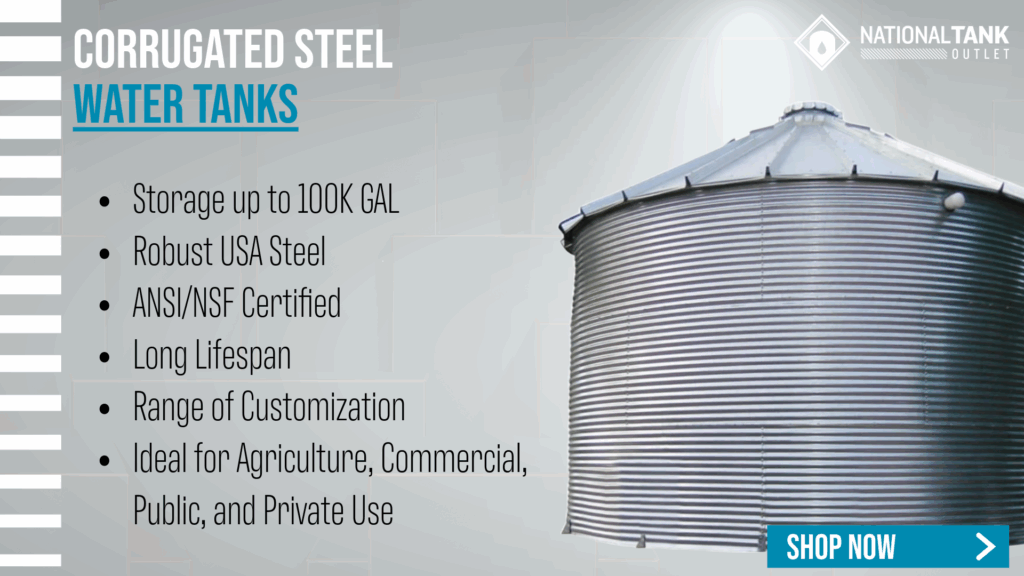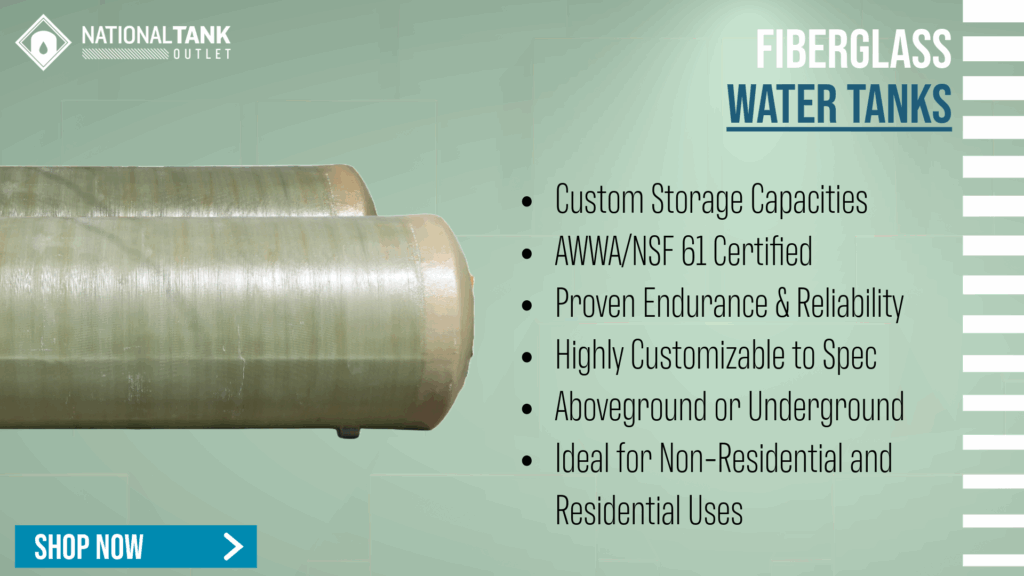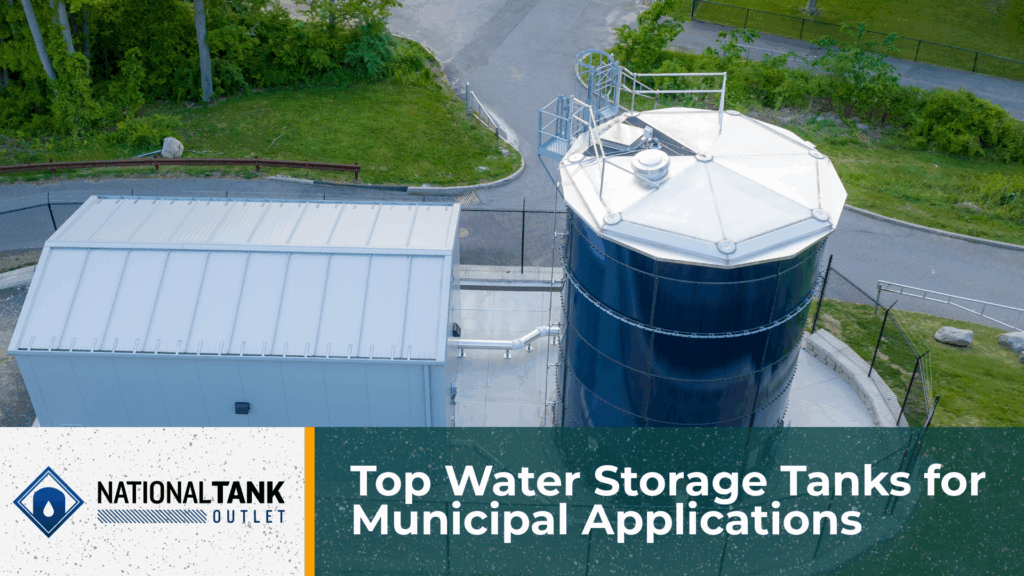
Selecting the right water storage tank is a pivotal decision for municipal systems and water management. Municipal water systems must balance high capacity demands, various applications, and strict regulations while ensuring the value of long term infrastructure. The type of tank chosen—whether for daily potable water, emergency reserves, or chemical storage—can affect not only system reliability but also a community’s ability to adapt and grow.
Here we’ll explore the primary types of water storage tanks for municipal applications. We will examine the features of each tank, their best use cases, and the points engineers and planners should consider during the selection process for a lasting, efficient water system.
Primary Tank Types for Municipal Water Storage
Municipalities rely on several primary tank types to meet large scale water storage needs. Each offers distinct advantages in terms of capacity, durability, and cost. The selection often depends on the specific application, whether for potable water reserves, fire protection, handling chemical agents, or raw water management.
Bolted Steel and Corrugated Steel Tanks
Bolted steel and corrugated steel tanks are a go-to solution for large capacity municipal applications. Their modular design allows for onsite assembly, making them highly scalable for main distribution reservoirs, fire protection systems, and raw water storage in preparation for treatment.
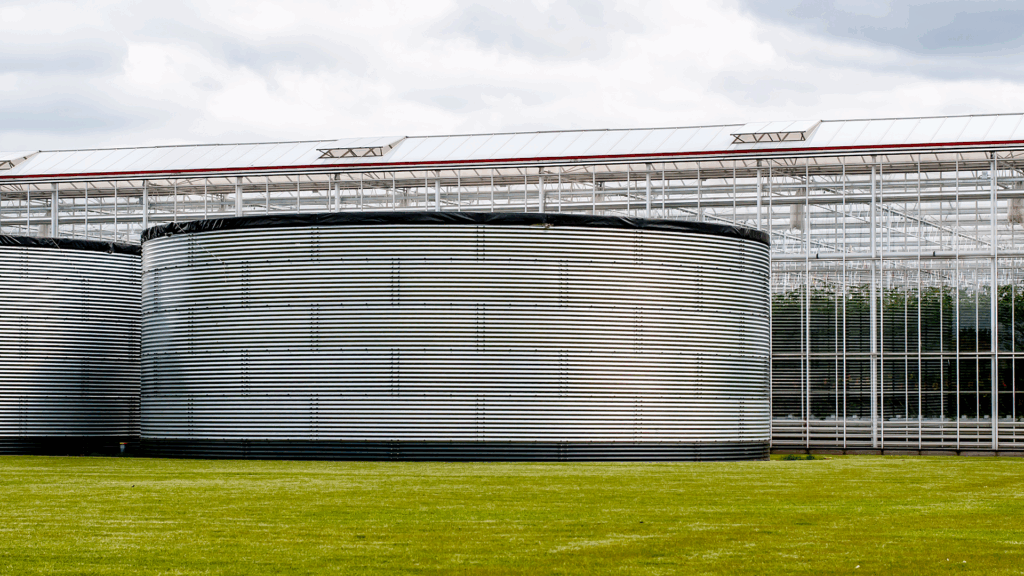
These tanks can hold from tens of thousands to over five million gallons and are a common choice for both ground level reservoirs and elevated water towers. To ensure longevity and water safety, they are often manufactured with corrosion resistant coatings and comply with AWWA and NSF 61 standards.
Glass-Fused-to-Steel Tanks
Representing a premium in durability, glass-fused-to-steel tanks merge the strength of steel with an inert, non-corrosive glass lining, but with a premium cost. This design provides an exceptionally long service life with minimal maintenance, making it ideal for storing potable water and supporting critical infrastructure. Their unique surface engineering prevents contamination and resists chemical degradation, which is why they are often specified for projects where long term reliability is priority.
Concrete Tanks
Reinforced and prestressed concrete tanks are a long standing, trusted option for municipal reservoirs. Often installed below grade, they are an excellent choice for sites seeking to minimize visual impact. These durable structures are built to withstand the elements and can hold millions of gallons, making them suitable for clearwells at water treatment plants and large, centralized potable water storage.
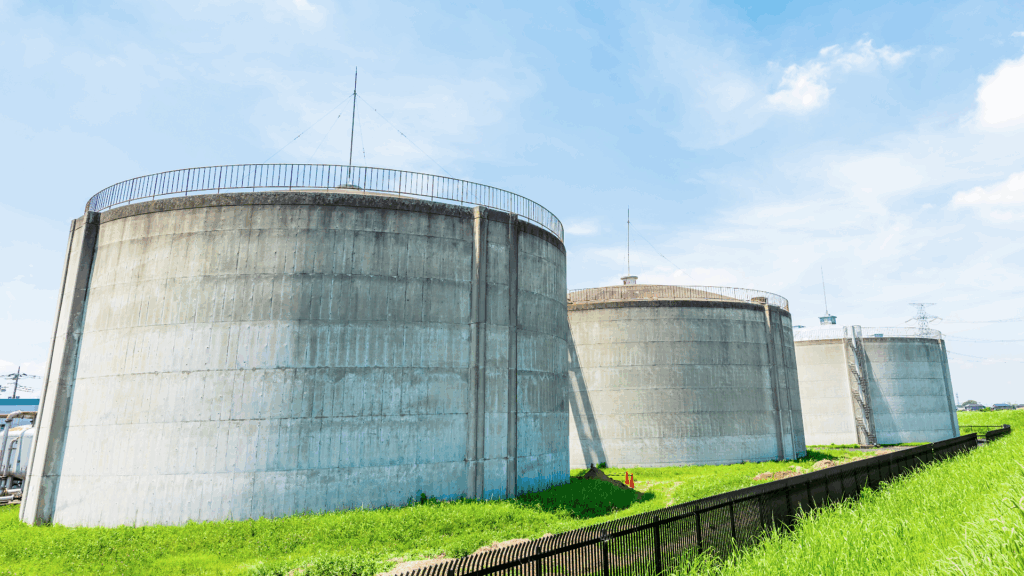
Supplementary and Specialized Storage Solutions
While large steel and concrete tanks form the core of municipal storage, smaller, more specialized tanks play an important role in the support of many secondary applications.
Polyethylene Tanks (Poly Tanks)
Polyethylene tanks, made from high density polyethylene (HDPE), are versatile and low cost by comparison solutions for supplementary municipal needs. Though their capacity is generally limited to around 20,000 gallons, the lightweight nature and corrosion resistance of poly tanks make them invaluable for specific tasks.
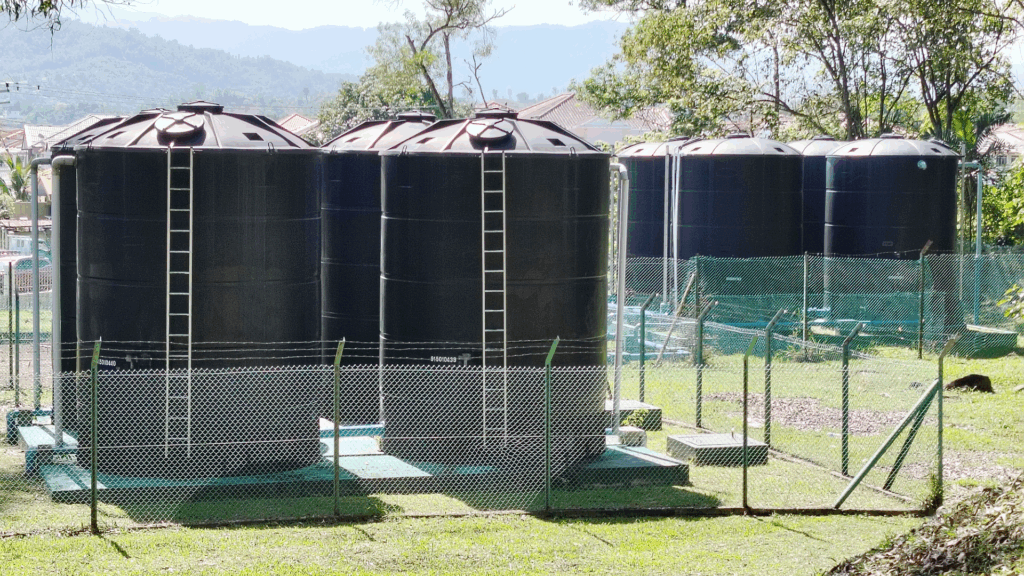
Municipalities often use poly tanks for:
- Emergency Water Reserves: They can be quickly deployed to provide drinking water to communities during a natural disaster or water main break.
- Rainwater Harvesting: Collecting rainwater in poly tanks for non-potable uses like park irrigation or vehicle washing to reduce strain on the primary water supply.
- Chemical Storage: Within water treatment facilities, poly tanks are used to safely store chemicals required for the purification process.
- Mobile Water Supply: The portability of certain models, such as leg tanks and IBC totes, allows them to be mounted on trucks or trailers for temporary water transport to remote sites or special events.
Because they are not designed for the massive volumes required for city-wide distribution, poly tanks are best viewed as a flexible supplement to larger storage systems.
Looking for a budget friendly solution for emergency reserves or chemical storage? Learn more about our polyethylene tanks.
Fiberglass Tanks
Fiberglass tanks are known for their strong chemical resistance, structural integrity, and built to spec design, which makes them ideal for specialized municipal applications. They can be installed above or below ground and are often customized to fit unique project requirements.

Common uses for fiberglass tanks include storing treated or reclaimed water, holding chemicals at treatment plants, or serving as secure underground backup water reserves.
Need help choosing the right tank for your municipality or bid project? Contact our experts for a consultation.
Comparing Municipal Water Storage Tanks
Choosing the right tank requires a clear understanding of how different materials and designs align with project needs. This table provides a quick comparison of the most common tank types.
| Tank Type | Typical Capacity | Common Applications | Key Standards |
|---|---|---|---|
| Bolted Steel | 20,000 – 5,000,000 gal | Potable water reservoirs, fire protection, raw water | AWWA D103, NSF 61 |
| Glass-Fused-to-Steel | 20,000 – 3,000,000+ gal | Critical potable water storage, harsh environments | AWWA D103, NSF 61 |
| Concrete | 50,000 – 10,000,000+ gal | Buried reservoirs, treatment plant clearwells | AWWA D110, D115 |
| Polyethylene (HDPE) | 500 – 20,000 gal | Emergency reserves, rainwater harvesting, chemical storage, remote water access | NSF 61 |
| Fiberglass | 1,000 – 50,000 gal | Underground reserves, reclaimed water, chemical storage | NSF 61 |
Key Points for Selecting a Municipal Water Tank
Beyond the type of tank itself, several points guide the decision making process for any municipal project.
Community Water Demand and Future Growth
A thorough analysis of current water usage patterns or water use estimates and projected population growth is the first step. The tank must be sized to meet daily peak demand and provide a sufficient emergency reserve, ideally without being unnecessarily oversized as this can lead to additional capital requirements and operational costs.
Site Conditions and Geography
The physical location dictates the feasibility of different tank types. Planners must evaluate space availability, soil stability, and site elevation. A large, flat area may be suitable for a ground storage tank, whereas a hilly region could leverage an elevated tank to generate gravity fed water pressure to help reduce energy consumption.
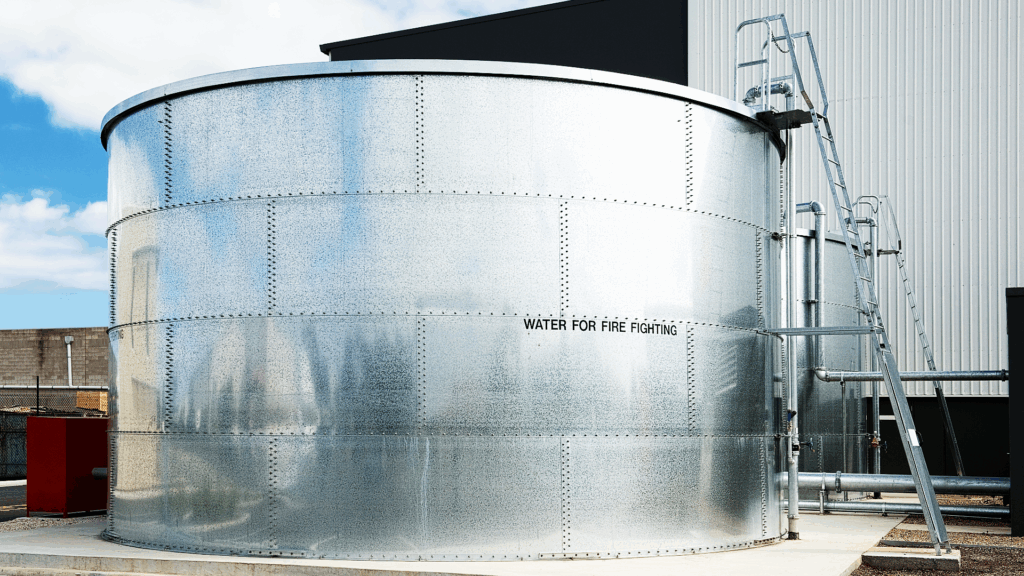
Maintenance, Durability, and Total Cost
A water storage tank is a long term investment, so durability is top ranking concern. Materials with high corrosion resistance, like glass-fused-to-steel or properly coated steel, minimize the need for repairs and extend the tank’s overall lifespan. Evaluating the total cost of ownership—including installation, maintenance, and operational expenses—is essential for making a financially responsible decision.
Compliance with Industry Standards
Municipal water tanks must adhere to set industry standards put in place to ensure public safety. Key certifications include:
- NSF/ANSI 61: Certifies that materials are safe for contact with water intended for human consumption.
- AWWA (American Water Works Association): Provides design and construction standards for steel, concrete, and composite tanks.
- NFPA 22 (National Fire Protection Association): Outlines standards for tanks intended for fire protection.
Growth and Innovation in Plastic Water Storage Solutions
In recent years, municipalities have increasingly adopted underground plastic tanks as part of their water storage strategies. These tanks, especially those made from high density polyethylene (HDPE), are gaining attention due to their flexibility, scalability, durability, and protection from environmental concerns. Underground installation not only saves valuable surface space but also helps protect reserves from temperature extremes, vandalism, and sunlight exposure that could otherwise compromise water quality.
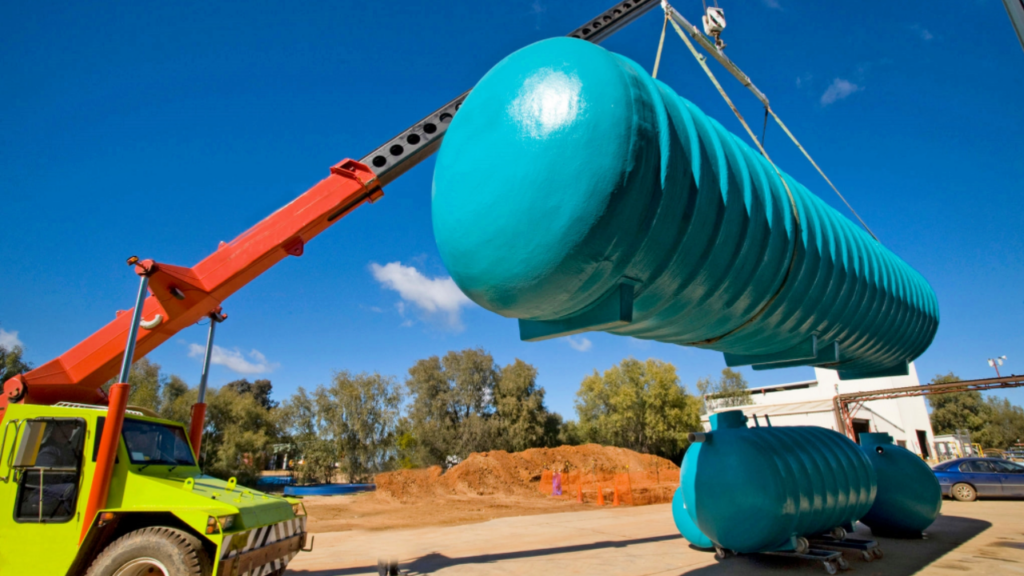
The market for plastic water storage tanks is projected to see significant growth in the years ahead, driven by rising construction activity, water conservation initiatives, and evolving municipal infrastructure needs. For municipalities, this trend is driving greater availability and innovation in plastic tank solutions—ranging from advanced multi-layer designs that restrict bacterial growth to lower cost options for both potable and non-potable uses. As plastic tanks become more common in municipal applications, water managers have at their disposal an expanding set of tools to address integrity, emergency preparedness, and sustainability in their water systems.
Featured Products for Municipal Water Storage
At National Tank Outlet, we offer a wide selection of modern storage tanks designed to meet the demands of municipal water systems. Here are our products best matched to your next municipal water project:
- Fiberglass Tanks: These tanks provide a secure, contamination resistant storage solution perfect for chemical storage, emergency reserves, or rainwater harvesting. Their below ground installation compatibility saves space while protecting your water supply from surface level risks. Fiberglass tanks are custom built to specification, with larger capacities and multiple resin manufacturing options available.
- Corrugated Steel Tanks: Well suited for rural or suburban municipal applications, corrugated steel tanks provide a balanced choice for large scale water storage needs, such as raw water reserves, irrigation, fire protection, or rainwater collection. Their modular design allows onsite assembly even for substantial capacities. Their unique corrugated panels make them different from bolted steel tanks, which often results in quicker installation times.
- Stainless Steel Tanks: Best suited for smaller scale or specialized municipal applications, stainless steel tanks are best where hygiene and water purity are top priorities. Their non-corrosive, non-porous, highly cleanable surface makes them ideal for auxiliary potable water storage or select industrial uses that require consistently high water quality.
- Polyethylene Tanks: Offering exceptional versatility and affordability, our polyethylene tanks are lightweight, UV protected, and impact resistant. They are an excellent choice for a variety of applications, from chemical storage for water treatment to holding potable water.
Investing in Your Community’s Water Future
Choosing the right municipal water storage tank is a decision that directly impacts the safety, reliability, and financial health of the community it serves for decades to come. Investing in the right water storage tank is an investment in your system’s future. Whether you need large scale potable water storage, specialized chemical tanks, or flexible emergency solutions, we have the expertise and products to meet your needs.
Ready to get started? Contact our team today for a free consultation or click below to request a custom quote.
